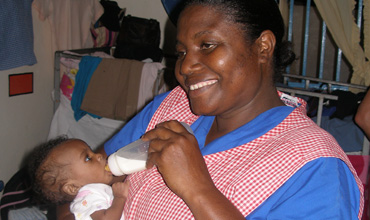The Capacity of Maids Training Centres to Train House Maids for Infant Care in Lusaka, Zambia

Abstract:
The
study aims at finding out the capacity of maids training centres in Lusaka to
training housemaids for infant care. Using both qualitative and quantitative
approach a collective case study was conducted. Questionnaires, interviews and
document analysis were designed and used to collect data. The interviews were
two types: in-depth interviews were held with ten housemaids randomly selected
from the twenty maids training centres. The maids training centres were
purposefully selected. The second interview was a focus group discussion where
the remaining ten house maids took part. The discussion was recorded and later
transcribed. This was subjected to thematic analysis. Document analysis was
also conducted to establish the type curriculum and how it was implemented.
The
findings from the data revealed that the housemaids were not trained to take
care of infants and that there is need to include the component of infant care
in the house maids training curriculum. It was clear from the findings that
maids training centers are not registered, their curriculum is not approved by
any organization and no quality assurance policy in place. These training
centers are run by former housemaids whose educational levels are low. The
instructional materials are inadequate, classes over crowded, and the training
duration too short (averaging 2 weeks). It was established that house maids are
not trained to take care of infants.
Keywords:
aids training centres, house
maids, infant care, curriculum, capacity, training
References:
[1] Adams, K. L. and Adams,
D. E. (2003). Urban education: A
reference Handbook. pp. 31–32. Oxford: ABC CLIO Inc.
[2] Adeogun, A.A. (2001). The principal and
the financial management of public secondary schools in Osun State. Journal of Educational System and Development. 5(1), pp.1 - 10.
[3] Archieve, B. (2008). Effect of Training
and Manpower Development on Productivity of Workers, New York, Harper and Row Publishers
[4] Aruna, P. and Rajah, D. (2011). Malaysia
getting ill trained maids. Asian News Network. Singapore press Holdings.
[5] Babayomi, A. O. (1999). Comparative study
of the teaching and learning resources in private and public secondary schools in
Lagos State. Master’s Thesis, Department of Educational Administration, University
of Lagos, Nigeria.
[6] Berument, S.K. (2013). Environmental environment
and caregiver training to support the development of birth to 6 year olds. 34(3),
189-201
[7] Bilbao, P. P., Lucido, P. I., Iringan,
T. C., and R. B. Javier (2008). Curriculum development. Philippines: Lorimar Publishing,
Inc.
[8] Braslavsky, C. (n. d.) The curriculum. Unpublished working document.
UNESCO International Bureau of Education.
[9] www.ibe.unesco.org/fileadmin/user_upload/archive/AIDS/doc/cecilia_e.pdf,
accessed on 6 September 2013.
[10] Craig,
H., Kraft, R., and du Plessis, J. (1998). Teacher development: Making an impact.
[11] Washington,
D.C.: Academy for Educational Development, ABEL Clearinghouse for
[12] Basic
Education.
[13] European
Centre for the Development of Vocational Training (2013). The role of qualifications
in governing occupations and professions. Working paper. Luxembourg: Publications
Office of the European Union
[14] Glăveanua,
S. M. and Gherghinescua, R. (2014). Nannies’ abilities to relate with the child
as predictors for professional performance. Bucharest: Elsevier
[15] Grobler,
P., Warnich, S., Carrell, M. R., Elbert, N. F. and Hatfield, R. D. (2006). Human Resource Management in South Africa. 3rd edition. London: Thompson Learning.
[16] Hancock,
D., Dyk, P. H., and Jones, K. (2012). Adolescent Involvement in Extracurricular
Activities:
[17] Influences
on Leadership Skills. Journal of Leadership Education, 11(1), 84-101
[18] Jones,
G. R., and George, J. M. (2005). Contemporary
Management. New York: Irwin and McGraw Hills
[19] Kelly,
A. V. (2009). The curriculum: Theory and practice (pp. 1–55). Newbury Park, CA:
Sage.
[20] Lombrozo,
T., Walker, C., Gopnik, A, & Legare, C. (2014). Explaining prompts children
to privilege inductively rich properties. Cognition,
133, 343-357
[21] Obe,
O. T. (2014). The effect of teachers’ qualifications on students’ performance in
mathematics. Sky Journal of Educational
Research Vol. 2(1), pp. 010 - 014, February, 2014
[22] Reys,
R., Reys, B., Lapan, R., Holliday, G., Wasman, D. (2003). Assessing the impact of
standards-based middle grades Mathematics curriculum materials on student achievement. Journal for Research in Mathematics Education:
74–95.
[23] Robson, C. (2011). Real World Research. 3rd edition. Chichester: Wiley.

